2.4 Education Provision & Key Indicators of Performance
Limerick City and County is well-serviced in its school and higher education infrastructure.
Primary and Special Schools
Across Limerick City and County, in the school year 2021/2022, there are 134 primary schools with 22,376 pupils. Of these, 24 schools are located in the city with 6,647 pupils and 110 in the former county with 15,729 pupils.
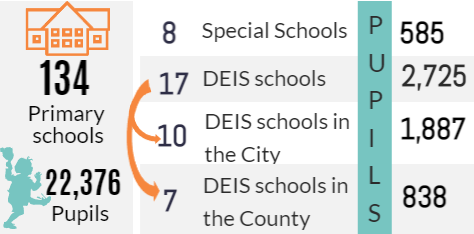
Of the total number of schools, 17 are designated as DEIS schools (servicing disadvantaged areas / with signifiant numbers of pupils from disadvantaged backgrounds) with 2,725 pupils. Of the DEIS schools, 10 are located in the city (with 1,887 pupils) and seven in the county (with 838 pupils). As such, just under 70% of the disadvantaged primary school popluation live in Limerick city.
Of the Limerick Primary schools, 681 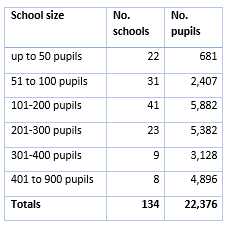 pupils are enrolled in very small schools (22 schools with up to 50 pupils) and an additional 2,407 pupils are enrolled in schools (31 schools) with 51 to 100 pupils. At the other end of the spectrum, 17 schools have 300 pupils and upwards, with one school having over 850 pupils. Six of the eight largest schools are located in suburban Limerick – Castletroy / Monaleen, Dooradoyle, Mungret and Corbally.
pupils are enrolled in very small schools (22 schools with up to 50 pupils) and an additional 2,407 pupils are enrolled in schools (31 schools) with 51 to 100 pupils. At the other end of the spectrum, 17 schools have 300 pupils and upwards, with one school having over 850 pupils. Six of the eight largest schools are located in suburban Limerick – Castletroy / Monaleen, Dooradoyle, Mungret and Corbally.
In addition, there are eight Special Schools in Limerick (e.g., for intellectually disabled, deaf, etc.) with 585 pupils in 2021/2022.
Source: Department of Education
Post-Primary Schools
In the school year, 2021/2022, Limerick City and County has 28 such schools aided by the Department of Education with 16,748 pupils. The number of pupils enrolled in 2021/2022 is approximately the same as in 2012.[1] The number of pupils decreased in the years 2017 to 2020 to under 16,000 pupils but has been increasing in 2021 and 2022. Fourteen of the post-primary schools are located in the city / urban catchment area and 14 in the more rurally-based county. Over recent years, there has been significant change in the school infrastructure. The number of second level schools has reduced from 33 in 2012 to 28 at present due to school closures and school amalgamations in both the city / urban catchment area and rural Limerick. New schools have been established over that period and there has been signficant investment in new school buildings.
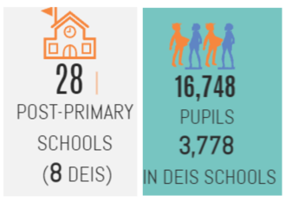 Of Limerick’s post-primary schools, eight are designated as DEIS schools (located in disadvantaged areas or serving disadvantaged populations), including one additional DEIS school designated for the city in 2022. In 2022, 3,778 pupils (23% of the school population) are enrolled in DEIS schools. Six of these DEIS schools are within the school population catchment area of the city / urban area and two in rural Limerick county towns.
Of Limerick’s post-primary schools, eight are designated as DEIS schools (located in disadvantaged areas or serving disadvantaged populations), including one additional DEIS school designated for the city in 2022. In 2022, 3,778 pupils (23% of the school population) are enrolled in DEIS schools. Six of these DEIS schools are within the school population catchment area of the city / urban area and two in rural Limerick county towns.
Retention Rates in School / Early School Leaving
In the state as a whole, retention rates to Junior Certificate and Leaving Certificate have shown steady improvement over the last ten years and the situation in Limerick follows this trend.[2] Based on the latest data - the 2014 school entry cohort, sitting the Junior Cert in 2017/2018 – national average retention rates to Junior Cert are 97.6%, showing an improvement of approximately 3 percentage points over ten years. For the same 2014 school entry cohort, sitting the Leaving Cert in 2019/2020, national average retention rates to Leaving Cert are 91.5%. Limerick City and County performs better than the state average on both indicators - with a retention rate of 98.1% to Junior Cert and 93.6% to Leaving Cert for the school entry cohort 2014.
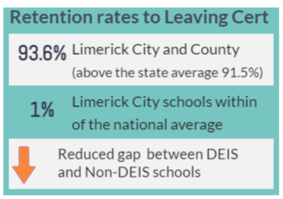 Cities and more urbanised local authority areas across the state have lower retention rates / higher Early School Leaving rates. Prior to amalgamation of Limerick City and Limerick County to form a single local authority in 2014, Limerick County performed well above the state average on retention in education and Limerick City well below the state average.[3] In Limerick City schools, retention rates to Leaving Cert over ten years ago (in the 2004 cohort, sitting the Leaving Cert in 2009/10) were 4% lower than the state average and the second lowest of all local authority areas in the state. In the last year for which data are available for Limerick City (2009 school entry cohort, sitting Leaving Cert in 2014/15), the gap in the retention rate to Leaving Cert for the city was less than 1%.
Cities and more urbanised local authority areas across the state have lower retention rates / higher Early School Leaving rates. Prior to amalgamation of Limerick City and Limerick County to form a single local authority in 2014, Limerick County performed well above the state average on retention in education and Limerick City well below the state average.[3] In Limerick City schools, retention rates to Leaving Cert over ten years ago (in the 2004 cohort, sitting the Leaving Cert in 2009/10) were 4% lower than the state average and the second lowest of all local authority areas in the state. In the last year for which data are available for Limerick City (2009 school entry cohort, sitting Leaving Cert in 2014/15), the gap in the retention rate to Leaving Cert for the city was less than 1%.
National level data shows a gender difference in retention rates to Leaving Cert (lower for males compared with females) and between DEIS and Non-DEIS schools. There has been a gap of between 3-4% in retention rates to Leaving Cert in favour of females since the 2012/2013 school entry cohort. Going back to students entering secondary school in the late 1990’s, the gap between males and females was much greater (10% gap in favour of female retention in school to Leaving Cert). Local Limerick data on the gender gap are not available but it is expected that a similar trend prevails.
Focusing on schools in disadvantaged areas and serving disadvantaged popuations, a gap in retention rates remains between DEIS[4] and non-DEIS schools but this has been reducing over time. The “achievement gap” in retention rates to Leaving Cert between DEIS and Non-DEIS schools currently stands at 8.6% - i.e., in the 2014 school entry cohort, sitting the Leaving Cert in 2019/2020 – and registers a further improvement compared with the previous year (9.3% gap). Males in DEIS schools are also more at risk of early school leaving (with a retention rate of 82.2% for males to Leaving Cert compared with 88.2% for females). It is also known from national level data that Travellers have lowest retention rates to qualification in second level education. Other groups most at risk of early school leaving are young people in the criminal justice system, and youth with mental health issues.
Third Level Education
There are three third level education institutions in Limerick offering courses at under-graduate and post graduate levels across a range of disciplines and with different profiles / specialisations: the University of Limerick (17,062 students), Technological University of the Shannon (TUS): Midlands and Mid-West[5] (11,999 students), and Mary Immaculate College (4,987 students). The last institution specialises in teacher training / education, early childhood education and liberal arts. These three institutions have seen an increase in student numbers in recent years and, in the 2021/2022 academic year, had a combined intake of 34,048 students.[6] The Limerick-based institutions are expected to expand further their stude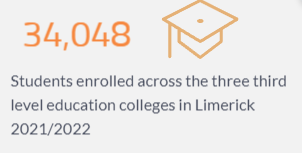 nt enrolments. University of Limerick is planning an increase in student registrations to 19,416 students by 2023/2024[7], LIT (now part of TUS) an increase to 7,500 students by 2022[8], and Mary Immaculate College forecasting a student population of up to 6,000 by the middle of the decade[9].
nt enrolments. University of Limerick is planning an increase in student registrations to 19,416 students by 2023/2024[7], LIT (now part of TUS) an increase to 7,500 students by 2022[8], and Mary Immaculate College forecasting a student population of up to 6,000 by the middle of the decade[9].
Further Education and Training & Apprenticeships
The Further Education and Training (FET) sector, operating under SOLAS, delivers life-long learning options to learners aged 16 years and upwards across the state. These include Post-Leaving Cert Courses (the largest proportion of courses), apprenticeships, traineeships, community education and core learning in literacy and numeracy. Courses are delivered by Education and Training Boards and other providers including community and voluntary groups. Courses are developed for, and certified at, different on the National Framework of Qualification, levels 1 to 6.
Across the state in 2020, excluding apprenticeships and e-Colleges, there were 151,630 enrolments. Of the enrolments, 108,793 learners achieved full or partial completions with 70% of those completing achieving certification.
The number of learners enrolled with Limerick as the county of residence was 7,557 or 5.2% of all learners in the state. This gives a rate of participation in adult learning of 49.4 per 1,000 population aged 16 years and over (2016), above the national average rate (39.6 per 1,000 population 16 years and over).
The profile of learners at county level is not reported but they are available at national level. Of the enrolments, 61.1% are female and 38.5% male; 44% are on full-time courses, 49% part-time and 6% online. In terms of age-profile, one-third are under 25 years. The education profile of those entering FET (enrolments) shows that this is reaching those with lower levels of education in general: over one-quarter (27%) of enrolments in 2020 have low education (Lower Secondary or below) and over one-third (36%) have Upper Secondary education. Just under one-fifth (19%) have some post-second level education and 15% a third level degree. In relation to employment status, approximately equal proportions are unemployed (30.5%) and employed (28.9%) while over 40% are economically inactive (retired, in home duties, otherwise inactive).[10]
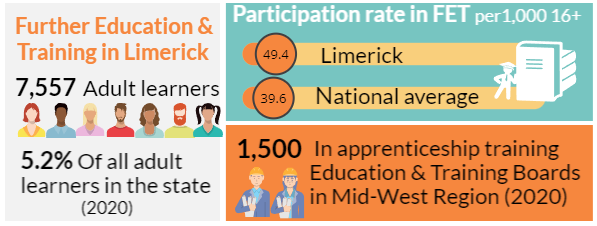
With a stronger focus on developing apprenticeship training to meet skills needs of employers / industrial and business sectors, the number in apprenticeship training in the state was 24,212 in 2021 with over 8,600 new registrations in that year.[11] The Education and Training Boards in the Mid-West Region had some 1,500 in apprenticeship training in 2020.
Progression to Third Level Education
Progression to third level education from school is an indicator of attainment in the school population on completion of second level (Leaving Certificate or equivalent). Over the last ten years, across all Post-Primary Schools in the city and county, rates of progression to college based on offers of places through the Central Applications Office (CAO) system have increased. The significant increase occurred over the earlier period from 2006 to 2012. In 2012, the rate of progression to third level colleges from all post-primary schools in Limerick City and County was 77% compared with 60% in 2006. Since 2013, it has been 80% (highest in 2019 and 2020 at 84%).[12]
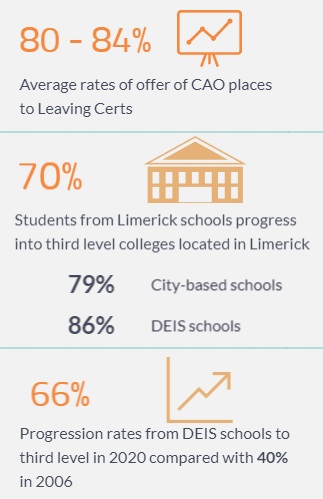 A significant change has been in the rate of progression from schools serving disadvantaged areas / school populations, DEIS schools. In 2021, the rate of progression to college from DEIS schools in Limerick City and County was 66% compared with 58% in 2012 and 40% in 2016. However, the gap between DEIS schools and non-DEIS schools remains significant. In 2021, the rate of progression from Non-DEIS schools was 85% compared with 66% for DEIS – a gap of 19%. While fluctuating over the years above and below 20% - the gap was lowest in 2018 at 17% and highest in 2015 at 29%.
A significant change has been in the rate of progression from schools serving disadvantaged areas / school populations, DEIS schools. In 2021, the rate of progression to college from DEIS schools in Limerick City and County was 66% compared with 58% in 2012 and 40% in 2016. However, the gap between DEIS schools and non-DEIS schools remains significant. In 2021, the rate of progression from Non-DEIS schools was 85% compared with 66% for DEIS – a gap of 19%. While fluctuating over the years above and below 20% - the gap was lowest in 2018 at 17% and highest in 2015 at 29%.
In schools in Limerick City / Urban area, where there are greater social inequalities, the same trends are in evidence. The gap in progression rates to third level education between DEIS and non-DEIS schools has been consistently greater in the city. In 2021, Non-DEIS schools in the city / urban area achieved a progression rate of 88% compared with 64% for DEIS schools (a gap of 24%). In recent years, the achievement gap was largest in 2015, at 32%.
The destination colleges for Limerick students’ progression to third level shows the importance of having third level education colleges located in Limerick. In the latest year (2021), 70% of second level offers of college places for students in Limerick schools were for institutions located in Limerick – University of Limerick, Mary Immaculate College and the Technological University of the Shannon: Midlands and Mid-West (TUS, formerly LIT). The percentage progressing to Limerick insitutions is higher for students from schools in the city / urban area (78% in 2021 go to colleges in Limerick). The availablity of college places in Limerick is more important for those students in DEIS schools, particulary from DEIS schools in the city / urban area. In 2021, the percentage of students from DEIS schools across Limerick City and County progressing into third level who went to Limerick-based colleges was 79%. In DEIS schools in Limerick City/Urban area, the percentage progressing to Limerick-based colleges was 86%. If DEIS schools located in or serving the most disadvantaged areas of the city (regeneration areas) are considered, the percentage of those students offered places at third level progressing to Limerick-based colleges is 93%.[13]
Graduate Outcomes and Retention of Graduates
Each year, approximately 10,000 students graduate from third level colleges in Limerick. Based on Graduate Outcomes surveys, in 2021, 76% of under-graduates gaining honours degrees from UL were in employment and a further 21% in further study nine months after graduation. In the case of TUS, 80% of honours under-graduates were in employment and 7% in further study nine months after graduation. Rates of entry to employment were higher for those graduating with post-graduate qualifications.
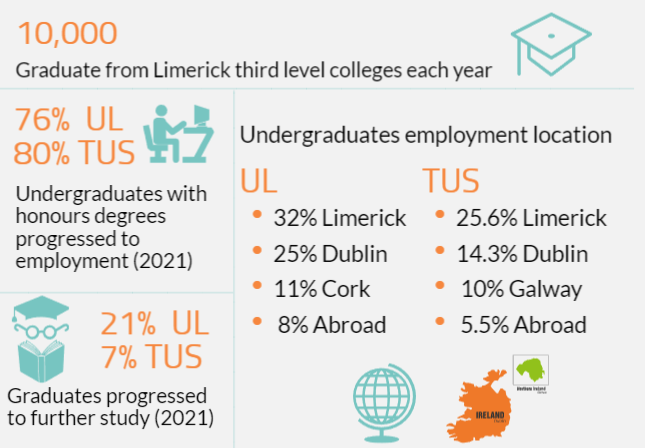 Of those UL graduates progressing to employment in 2021, for 92%, the location of employment was Ireland while 8% took up employment abroad. In terms county location, 32% of UL graduates taking up employment went into employment in Limerick, 25% Dublin and 11% Cork. In the case of TUS, 94.5% went into employment in Ireland and 5.5% abroad; 25.6% took up employment in Limerick, 14.3% Dublin and 10% Galway. While this shows the importance of the third level colleges generating an educated workforce for businesses in Limerick, it also shows some leakage of talent out from the county and the region i.e., reflected in the significant percentage of graduates taking up employment elsewhere in Ireland as well as a small proportion abroad.
Of those UL graduates progressing to employment in 2021, for 92%, the location of employment was Ireland while 8% took up employment abroad. In terms county location, 32% of UL graduates taking up employment went into employment in Limerick, 25% Dublin and 11% Cork. In the case of TUS, 94.5% went into employment in Ireland and 5.5% abroad; 25.6% took up employment in Limerick, 14.3% Dublin and 10% Galway. While this shows the importance of the third level colleges generating an educated workforce for businesses in Limerick, it also shows some leakage of talent out from the county and the region i.e., reflected in the significant percentage of graduates taking up employment elsewhere in Ireland as well as a small proportion abroad.
[1] Data from Department of Education statistics database. https://www.gov.ie/en/publication/055810-education-statistics/#education-statistics-database
[2] The retention rate to Leaving Cert is used as a measure of Early School Leaving (ESL). However, retention rates in mainstream schools do not take into account participation in educational pathways outside the school system, such as Youthreach and apprenticeship training, or early entry into the labour force (Department of Education, 2020). If participation in alternative educational pathways were included – e.g., measured by the completion of the National Framework of Qualifications levels of 4, 5 and 6 – retention rates to completion of second level qualification would be even higher and Early School Leaving Rate lower.
[3] With the amalgamation of Limerick City and County Council (2014), there is a break in the statistical series for Limerick. The former City and former County are no longer are reported separately. As such, the actual figures for Limerick City are not available for any of the years from 2015/2016 onward.
[4] DEIS (Delivery Equality of Opportunity in Schools) schools are those supported with a special support programmes and higher levels of capitation because of the profile of their pupils intake as socially disadvantaged / location in socially disadvantaged communities.
[5] Formerly Limerick Institute of Technology (LIT) including Limerick School of Art and Design amalgamated with Athlone Institute of Technology to create TUS: Technological University of the Shannon: Midlands and Mid-West, beginning operations in October 2021. It operates across six campuses in four counties: Limerick, Athlone, Thurles, Clonmel and Ennis
[6] Higher Education Authority statistics, Sept 2022. https://hea.ie/statistics/
[7] University of Limerick Strategic plan 2019-2024 [Online: https://www.ul.ie/UL_Strategic_Plan_2019-2024_Web.pdf
[8] Limerick IT Strategic Plan 2018-2022 [Online: https://lit.ie/getmedia/1c35e9a1-974f-4125-b6fbd075511249ec/LIT-Strategic-Plan-2018-2022.pdf]
[9] Mary Immaculate College Strategic Plan 2023, p. 20 [Online: https://www.mic.ul.ie/about-mic/office-ofthe-president/strategic-plan]
[10] SOLAS Data Analytics https://www.solas.ie/f/70398/x/cdfb3456d9/15665-fet_facts_report_2020.pdf
[11] The target number of new registrations per year is 10,000 from 2021 to 2025 under the Action Plan for Apprenticeship 2021-2025
[12] Data collated from www.schooldays.ie published data on progression statistics from Limerick-based post-primary schools excluding “grind” schools and LCFE
[13] Data collated from analysis of individual school returns, data published on www.schooldays.ie